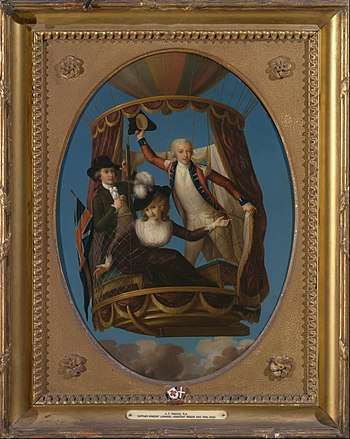Letitia Ann Sage

Letitia Ann Sage (née Hoare; c.1750–1817) was the first British woman to fly, making her ascent on 29 June 1785, in a balloon launched by Vincenzo Lunardi from St George's Fields in London.[1]
She is thought to have been an actress, who appeared at Covent Garden in 1773, and at some point lived with a haberdasher whose name she took, calling herself "Mrs Sage".[2] She is known to have resided for a time at No. 10, Charles Street, Covent Garden. She had two sisters, who were also actresses: Mrs Sarah Ward (c.1753-1838) and Mrs Kate Powell (c.1762-1807). Sarah was the wife of Thomas Ward, who was manager of the Manchester Theatre, whilst Kate's husband was Sparks Powell.[3]
A flight was first planned by Lunardi in September 1784, when he and Mrs Sage were due to ascend from London, but, as was common in the early days of ballooning, the weight proved too great to allow the balloon - which relied on an adequate supply of hydrogen[4] - to get off the ground, and Mrs Sage was obliged to get out, her place taken by three animals: a pigeon, a cat and a dog.[5]
The original plan was for Mrs Sage and Lunardi himself to make the ascent along with his assistant and another guest, Colonel Hastings, who had been promised a place only if the balloon proved capable of carrying four passengers.[6] However, the balloon was unable to take off with the weight of all three passengers, so Lunardi got out, along with Hastings, and their place was taken by Lunardi's friend and assistant, George Biggin, who had financed the flight.[7] Biggin and Mrs Sage were in the air for an hour and a half, finally coming to rest in a farmer's field near Harrow, where they were assisted in getting down by some schoolboys. In the course of the journey they had time to eat a meal and drink some wine, discarding the bottle over the side.[8]
Mrs Sage went on to write about her experiences in a short publication titled A Letter, Addressed to a Female Friend, By Mrs. Sage, the First English Female Aerial Traveller, which was printed later in the year and sold at a price of one shilling.[2]
A depiction of the balloon flight, showing three passengers, had been created in advance by John Francis Rigaud.[9]
Mrs Sage gained some notoriety for her achievement, but by 1804 she was working at Sadler’s Wells Theatre, under the name of "Mrs Robinson", as a dresser and wardrobe keeper for Charles Dibdin the younger.[2] From there, she moved on to the Crow Street Theatre, Dublin, and later to Drury Lane. Nothing is heard of her after 1817.[2]
References
- ↑ "Mrs Sage, first English female aeronaut". Science Photo Library. Retrieved 7 April 2018.
- ↑ Mark Davies (2015). King of All Balloons. Amberley. p. 270. ISBN 9781445653082.
- ↑ Gavin Stamp (1 December 2013). Anti-Ugly: Excursions in English Architecture and Design. Aurum Press Limited. p. 225. ISBN 978-1-78131-123-3.
- ↑ Shayler David; Ian A. Moule (29 August 2006). Women in Space - Following Valentina. Springer Science & Business Media. p. 9. ISBN 978-1-84628-078-8.
- ↑ Mrs. L. A. Sage (1785). A Letter Addressed to a Female Friend: By Mrs. Sage, the First English Female Aerial Traveller; Describing ... Her Expedition with Mr. Lunardi's Balloon; ... 29th June, 1785, Accompanied by George Biggin, Esq. writer, and sold. p. 11.
- ↑ Charles Paul May (1962). Women in aeronautics. Nelson.
- ↑ Mrs. L. A. Sage (1785). A Letter Addressed to a Female Friend: By Mrs. Sage, the First English Female Aerial Traveller; Describing ... Her Expedition with Mr. Lunardi's Balloon; ... 29th June, 1785, Accompanied by George Biggin, Esq. writer, and sold. p. 28.
- ↑ "V. Lunardi, Mrs Sage and G. Biggin in a Hot Air Balloon". Museo del Prado. Retrieved 7 April 2018.